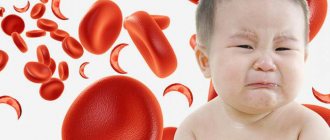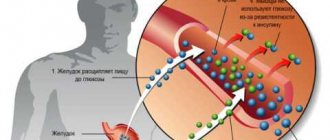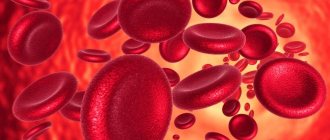Functions of iron (Fe)
The total amount of iron in the body is approximately 4-5 grams.
About 70% of the iron received from food is included in hemoglobin, that is, it is spent on providing tissues and organs with oxygen. This is why hemoglobin and iron levels are sometimes associated with each other, but hemoglobin and iron are not the same thing. About 10% of iron is needed for myoglobin, which is involved in the exchange of oxygen and carbon dioxide in muscle tissue. Approximately 20% is stored in the liver as a reserve. And only 0.1% combines with protein and circulates in the blood plasma. Low iron in the blood can interfere with various processes in which this element takes part. Fe in the body is necessary for:
- Transportation of oxygen and carbon dioxide:
- Production of fresh blood;
- Metabolism and energy;
- DNA production;
- Maintaining immunity;
- Production of thyroid hormones;
- Normal course of redox reactions;
- Destruction of toxic substances in the liver.
Of course, this is not the entire list of iron’s functions in the body. Deviation of iron from the norm affects the condition of the skin, hair and nails. In order for all systems to work properly, it is important to regularly monitor iron levels.
An iron test is usually prescribed if any abnormalities have been detected in a general blood test or in the study of hemoglobin, red blood cells or hematocrit. The analysis is also used in the treatment of anemia, poisoning with iron-containing medications and suspected iron overload in the body.
Necessary tests
Determining the iron content in the blood is quite simple.
It is enough to turn to the most common and simplest method - laboratory testing of blood taken from a finger. This test helps determine the level of hemoglobin in the human body. Also sometimes a more complex and detailed analysis of blood from a vein is required. It is important to monitor your health from time to time and monitor your blood counts so as not to miss the development of a pathological condition. And if a person has the first signs of low iron, and serum iron is also low, then it is worth immediately undergoing an examination. The concentration of serum iron in the blood is quite unstable.
Does it happen that a person has a critically low level of iron in the blood, but the hemoglobin level remains normal? Unfortunately, this misleading condition also occurs quite often. Most experts believe that serum iron levels are the primary outcome after testing. The normal level of iron in the blood is a condition that depends on many factors.
Reduced iron levels, but with normal hemoglobin levels are observed at two stages of the development of iron deficiency. Low iron in the blood with normal hemoglobin is observed in these two cases:
- Prelatent state.
The tissue depot is devastated, but the transport and hemoglobin fund is preserved. Absence of any clinical signs.
- Latent stage (hidden) of iron deficiency.
There is a reduced content of iron in the depot and transport iron. The activity of many enzymes decreases, the level of hemoglobin remains at the same level.
If iron is low, hemoglobin is normal - this is a condition that requires mandatory treatment. Since these are only “signals” that disturbances have occurred in the body. To prevent the development of the disease, you should go to the hospital with laboratory test data.
Low metal content in the body leads, first of all, to oxygen starvation of all tissues and systems. Anemia necessarily requires therapeutic correction. Having figured out what this means - an adult has low iron, you need to find out how to treat the causes of low iron in the blood.
If the percentage of transferrin saturation with iron is reduced, then it is necessary to eliminate the cause that caused this condition. Among the diseases that could cause this situation are hemolytic anemia, chronic poisoning with iron or other substances, and an inflammatory process in tissues. You can begin saturating the body with iron-containing preparations only after the cause of this condition has been eliminated.
If the coefficient of transferrin saturation with iron is reduced, then this is a sign of a reduced process of iron delivery to the erythrocyte germ. In this case, the doctor can diagnose the following pathologies: malignant tumor, cirrhosis, inflammatory process and some others. Only after the underlying cause has been eliminated is it recommended for a person to take iron supplements and normalize their diet.
Weakness, fatigue, and poor health have probably been experienced by every person, be it an adult or a child. The cause of this complex of ailments is often a decrease in the vital microelement contained in the blood - iron, since it regulates many of the most important physiological processes in the body and is literally responsible for iron health. Why is this microelement so important, what are the normal values and what to do if the level of iron in the body is low?
This element enters the body together with foods. After the iron is absorbed in the intestines, it enters the bloodstream. Excesses are deposited in the liver, bone marrow and spleen if they are not used by the body, as they are not excreted naturally. Most of the iron (60-70%) is found in hemoglobin, but this is not the same thing.
Its main functions:
- maintaining normal cholesterol levels;
- participation in hematopoiesis;
- transport of oxygen in the body;
- preventing the development of anemia;
- assistance in the production of thyroid hormones that affect metabolic reactions.
Iron regulates redox processes, supports the immune system, and promotes the synthesis of the myoglobin protein, which is involved in the contraction of muscle tissue.
In the blood, the normal number of the element is:
- for men – 11-30 µmol/l;
- for women – 9-30 µmol/l;
The iron level in children varies depending on age: in newborns - 17-45 µmol/l, up to two years - 7-8 µmol/l, over two years - at the level of adults.
The average daily normal intake of iron in an adult is 20-25 mg. This is exactly what the body needs for normal functioning.
Iron levels are determined using a biochemical blood test. The study is carried out in the following cases:
- there is a suspicion of intoxication of the body with iron-containing drugs;
- infectious diseases;
- pathologies of the digestive system;
- monitoring the effectiveness of treatment.
Blood sampling is carried out in the morning, on an empty stomach. On the eve of the test, it is recommended to refrain from eating for 12 hours, avoid heavy physical and emotional stress, and not smoke 2-3 hours before.
As a result of high iron content, there are detrimental effects on the body. Men of any age, children, and women during menopause are especially at risk. Most often, this problem does not occur for donors who regularly donate blood.
In order to avoid the negative effects of a large amount of this element on the body, it is necessary to periodically determine its level. If necessary, the doctor will give recommendations on ways to reduce iron.
For example, what medications to take, what diet to follow. If there are no contraindications, you can become a donor.
Nutrition
It is necessary to review the principles of nutrition and include in the menu foods that help reduce metal, for example:
- Rice groats are good at removing excess microelements, including iron;
- dairy and fermented milk products containing calcium in large quantities, since its excess interferes with the absorption of the metal.
It is possible to lower iron levels by reducing foods high in vitamin C and B vitamins in the diet, which promote the absorption of iron.
You should not eat protein and vegetables or fruits rich in them together. For example, you don’t need to eat an apple or citrus for dessert if the main dish was meat.
For chronic increases in iron and its deposition in organs, special medications are prescribed. Doctors usually prescribe hepatoprotectors, zinc-containing agents, heptapeptides, and complexing agents.
Calcium thetacin and desferal (deferoxamine), which binds iron, help reduce the amount of metal.
If poisoning by an element is severe, an exchange blood transfusion is used, when blood is taken from the patient and a donor transfusion is performed at the same time.
Traditional methods
Hirudotherapy is often recommended as a folk remedy to normalize iron levels. Leeches, by sucking blood, reduce the amount of this metal.
At home, you can use mumiyo by consuming it in a 10-day course of 0.2 grams per day. At the end of the treatment, take a break for 5-7 days, then resume treatment.
If iron levels are high, it is recommended to avoid cooking in metal utensils and replace them with ceramic or glass ones.
If a blood test reveals a high iron content, then treatment (traditional or folk remedies) should be started only after consultation with a doctor.
Nutrition
Serum iron is a microelement that enters the human body with food. It is distributed to all tissues with the help of a special protein – transferrin, the synthesis of which occurs in the liver. Without sufficient iron in the blood, the formation of hemoglobin is impossible (iron is the main component of heme, a protein that allows the transport of oxygen from the lungs to cells and tissues).
This does not limit the biological significance of the substance in question. Serum iron is necessary for the enzyme that oxidizes methane to methyl alcohol. It is part of the enzyme ribonucleotide reductase, without which the process of DNA synthesis is impossible. Therefore, it is quite difficult to overestimate the importance of the microelement in question for humans.
The substance is deposited in a special protein complex – ferritin. This way the trace element can be stored in a form that is non-toxic to human tissue. Up to 30% of the total iron level in the blood is in deposited form.
According to Russian recommendations, the daily iron requirement for women is 18 mg, and during pregnancy it increases to 30 mg. For men, daily intake should not be less than 10 mg.
The substance is supplied with food. However, no more than 10% of the total amount of incoming microelement is absorbed. Iron in food is divided into:
- heme - found in meat products, as part of hemoglobin;
- non-heme – comes from plant foods in combination with proteins, for example, ferritin or enzymes.
The absorption efficiency of heme iron is up to 35% higher than that of non-heme iron. The full absorption of the latter is influenced by various factors. For example, ascorbic acid activates the absorption process, while eggs, caffeine and calcium, on the contrary, hinder it.
The record foods for iron content are liver and red meat. Pumpkin seeds, red apples, dates, figs, sesame seeds, cereals, parsley and lettuce are also beneficial.
Interesting fact: for a long time, spinach was considered a record-breaking product. A similar error was made as a result of typos in research data where the zero after the decimal point was not indicated in the data.
Increased iron in the blood
Fe enters the body with food and is transported throughout all tissues in combination with protein. The process of iron entering tissues and reserve reserves is designed in such a way that excess iron is not absorbed, that is, ideally the body secretes as much iron from food as it needs. If there is a lot of iron in the blood, we can assume an accelerated breakdown of red blood cells, as a result of which all the included chemical elements are released into the blood. Increased iron levels in the blood may have the following causes:
- Various forms of anemia.
- Failure of the mechanism of iron absorption in the gastrointestinal tract, in which all the iron entering food is absorbed into the intestines. This phenomenon is called hemochromatosis.
- An excess of iron in the body can be caused by taking medications containing iron or repeated transfusions of someone else's blood.
- Poisoning with heavy metals, in particular lead.
- Use of oral contraceptives.
- Points 4 and 5 affect the process of hematopoiesis and especially the inclusion of iron in red blood cells, as a result of which an increased iron content in the blood may be observed.
- Various liver lesions.
We should also talk about the symptoms of excess iron in the body. In addition to the fact that an excess of this element complicates the course of Parkinson’s and Alzheimer’s diseases, other signs of high iron levels in the blood may be observed:
- Yellowish color of the skin, tongue and mucous membranes;
- Increased liver volume;
- Weakness;
- Change in heart rate;
- General pallor;
- Weight loss;
- Itching;
- The appearance of pigment spots on the palms, in the armpits, in the place of old scars.
Based on symptoms alone, you should not draw a conclusion about the status of iron in the blood, since some symptoms of iron deficiency mean the same thing as high iron in the blood. The only reliable fact is the result of the analysis, carried out according to the rules in a trusted medical laboratory. To obtain reliable results, the morning before donating blood, you should avoid physical and emotional stress.
Treatment
Bringing iron levels in the blood back to normal should start with your diet. You need to know that calcium contributes to the deterioration of iron absorption. Products containing iron, as well as B vitamins and vitamin C should be excluded from the diet.
In case of iron intoxication due to taking iron-containing drugs more than 30 mg/kg, gastric and intestinal lavage is performed. Therapeutic bloodletting is also prescribed, when half a liter of blood is released to the patient once a month.
The course of treatment should be repeated after four months.
To avoid the development of anemia, the patient is prescribed Deferoxamine for prophylactic purposes - 20-30 mg/kg per day. A synthetic hormone was also synthesized, which does not have hormonal activity, but promotes the rapid removal of iron from the body. If the disease is accompanied by one of the types of anemia, separate treatment with pyridoxine in combination with ascorbic acid is prescribed.
Thus, from this article we learned what an increase in iron in the blood can lead to.
Weakness, fatigue, and poor health have probably been experienced by every person, be it an adult or a child. The cause of this complex of ailments is often a decrease in the vital microelement contained in the blood - iron, since it regulates many of the most important physiological processes in the body and is literally responsible for iron health. Why is this microelement so important, what are the normal values and what to do if the level of iron in the body is low?
How to reduce iron in the blood?
The first thing you need to do is change your diet, because all iron enters our body only with food. For adult men, the daily requirement for iron is defined as 10 mg, for women - 20 mg, because they consume iron in large quantities during menstrual periods. Children should consume from 4 to 18 mg of iron per day, and expectant mothers in the second half of pregnancy and the first quarter after childbirth need 30-35 mg of this element.
It is recommended to add dairy products to your diet. You can avoid or regulate the increase in iron in the blood by including milk and dairy products in your diet. The fact is that they contain a large amount of calcium, which interferes with the normal absorption of iron; as a result, iron is not retained in the intestines and does not remain in excess.
But vitamins C and B12, on the contrary, improve the absorption of iron and can cause excess iron in the blood. We will talk in more detail below about where these vitamins are found.
Another effective way to combat excess iron in the blood is not related to nutrition, but to blood loss. The fact is that blood transfusion provokes a constant process of production of “new” blood, which turns out to be healthier and with a normal level of hemoglobin. Therefore, if according to the results you have increased iron in your biochemistry, it’s time to become a blood donor.
Another option is also associated with bleeding, but already involves the use of leeches. This method is called hirudotherapy and is used not only to normalize iron levels, but also for the overall health of the body.
Phlebotomy is used in cases where excess iron levels in the blood are not caused by serious diseases, but only by poor nutrition, and it is necessary to normalize the blood without the use of medications.
Removing iron from the body
It should be noted that iron, unlike most other macronutrients, is not excreted naturally from the body. Thus, all the iron that is not used by the body in the process of life and not removed from it (i.e., no more than 1 mg per day) begins to accumulate in it. A decrease in its amount can occur due to some kind of blood loss or during fasting, when, due to the lack of external supply of necessary substances, the body has to use its own reserves for its functioning.
Low iron levels in the blood
Our body does not produce iron on its own; its entire supply enters tissues and cells only through nutrition. Therefore, the main cause of low iron levels in the blood is insufficient or improper nutrition. This could be illiterate vegetarianism or, on the contrary, indiscriminate consumption of fatty, iron-depleted foods. Switching to a dairy diet also contributes to Fe deficiency, because calcium, contained in large quantities in dairy products, reduces iron-binding capacity, as a result of which iron is simply not absorbed in the body.
The following phenomena also contribute to the reduction of iron:
- High consumption of microelements caused by rapid growth of the body (for example, when a child is under 2 years of age, during puberty in adolescents and during pregnancy and breastfeeding).
- Gastrointestinal diseases leading to iron deficiency anemia (for example, enteritis, gastritis, neoplasms, etc.).
- If iron in the blood is low, the reasons may be inflammatory, purulent infections and malignant neoplasms, because they lead to the fact that cells begin to intensively absorb iron from the blood plasma, resulting in its deficiency in the blood.
- Hemosiderosis.
- Kidney pathologies.
- Liver cancer or cirrhosis.
- Low iron in the blood in women can be caused by prolonged bleeding during menstruation; bleeding through the nose, gums or after an injury also provoke iron deficiency.
- Other vitamins and microelements also affect the absorption of iron in the body. As we have already said, calcium in excess prevents the absorption of iron, while ascorbic acid, on the contrary, promotes it. Therefore, before increasing iron in the blood using various medications, you need to adjust your diet, otherwise the treatment may be ineffective.
At first, iron deficiency in the body occurs without any symptoms. Then, when the iron reserves in the liver are depleted, the person begins to chronically experience weakness, malaise, dizziness and migraines. Already at this stage, you should ask yourself what to do if there is not enough iron in the body.
The next stage of development of iron deficiency anemia is manifested by weakness in the legs, shortness of breath, pain in the chest, unusual taste preferences (for example, the desire to eat clay or chalk), etc.
Consequences of excess iron
If the iron norm is exceeded, this indicates the development of any diseases and dysfunction in the body, for example:
- about a lack of vitamins B6, B12, folic acid;
- about the presence of anemia of any type;
- about poisoning of the body with products containing excessive amounts of Fe.
Excess iron is possible if its excretion from the body is impaired, for example, with acute or chronic hepatitis.
In adults
An excess of iron is dangerous due to the following consequences:
- there is a risk of developing liver disease, most often cirrhosis, which can cause cancer;
- pancreatic diseases, increased blood sugar, and as a result - diabetes;
- problems in the functioning of the cardiovascular system, because excess iron provokes heart failure.
Many people report frequent mood swings, incomprehensible fatigue and weakness. In addition, in adults, sexual activity decreases and problems with reproductive function appear. Men may be at risk of developing impotence, and women may experience menstrual irregularities.
How to increase iron in the blood?
Eating foods high in iron is not enough. In order to accurately bring your blood counts back to normal, you need to consume enough vitamins C, B12 and protein. The latter is necessary for the construction of hemoglobin, which will later become part of red blood cells and will work to enrich the body with oxygen.
Broccoli is an excellent food in this case, as it contains both iron and ascorbic acid. Dress your salads with lemon juice, and also include tomatoes, lentils, sauerkraut, bell peppers and avocados in your diet.
Low iron during pregnancy can be caused by a deficiency of folic acid or vitamin B12. Expectant mothers are usually prescribed it as a food supplement in tablet form. In general, folic acid is found in sauerkraut and kefir. It has a positive effect on the intestinal flora and is even produced by the body itself.
Iron is found in foods such as buckwheat, mussels, apples, beets, fish, meat, eggs, carrots, apples, broccoli, beans, chickpeas, spinach, etc.
Before increasing iron levels in the blood, you must undergo an examination and consult a doctor. Perhaps the deviation is caused by much deeper and more serious processes compared to the diet.
Factors influencing the result
It is believed that 1 tablet of an iron-containing drug can temporarily increase the concentration of the substance in the body. It is also worth considering that alcoholic beverages, estrogen-containing medications and oral contraceptives increase the concentration of this substance in the blood.
The female body independently normalizes the concentration of iron in the blood.
Especially when a woman is about to menstruate: then the concentration of the substance increases, and after menstruation it decreases, restoring the balance. But if the bleeding is profuse, then there is a strong decrease in the substance in the blood, which provokes anemia.
The results of the study are also affected by:
- Time of day (iron levels are highest in the morning and decrease in the evening).
- Sleep and stress (chronic lack of sleep and frequent worries reduce the amount of the substance in the blood).
The norm of iron and the reasons for its deficiency in the human body
Women of childbearing age are most at risk for iron deficiency due to blood loss during menstruation. Women aged 18 to 50 years are recommended to consume 18 mg of iron per day.
Pregnant women should consume 27 mg per day. Adult men need about 8 mg of iron per day.
There are several reasons why a person may be iron deficient:
- Poor nutrition . Scientists distinguish between two types of iron: heme iron, obtained from animal sources (beef, liver, oysters), and non-heme iron, obtained from plants (buckwheat, legumes, spinach). Heme iron is best absorbed by our body. Long-term consumption of foods low in heme iron contributes to lower levels of this mineral in the body.
- Pregnancy . Iron is required for fetal development, so increased iron intake is recommended for pregnant women.
- Heavy menstrual bleeding in women. Normally, menstruation lasts 4-5 days and the amount of blood lost is approximately 2-3 tablespoons.
- Internal bleeding . Hidden internal bleeding can be caused by an ulcer, polyps or intestinal cancer. Frequent use of aspirin can also lead to stomach bleeding.
- Problems with iron absorption . Even if your diet is rich in iron, certain diseases can impair its absorption. These include, for example, celiac disease or gastric bypass surgery.
How to diagnose iron deficiency?
To determine the iron content, a detailed blood test is used, which will show the quantitative content of hemoglobin, hematocrit, platelets, red and white blood cells.
Diagnosis of anemia is based on red blood cell size, hemoglobin and hematocrit , which is determined by the percentage of red blood cells in the blood. Normal hematocrit is 34.9-44.5% for women and 38.8-50% for men.
An adequate hemoglobin level corresponds to 120-155 g/l for women and 135-175 g/l for men. The size and color of red blood cells are determined under a microscope, and pale red blood cells will also indicate iron deficiency.
To complete the diagnosis, the doctor can find out the content of ferritin and transferrin in the blood.
Kovaleva Elena Anatolyevna
Doctor-Laboratory Assistant. 14 years of experience in clinical diagnostic services.
Ferritin is a protein that indicates how full the body's iron stores are. Low ferritin levels indicate that reserves are depleted.
Transferrin is a protein that transports iron; its quantity shows the body’s ability to bind iron atoms for their subsequent transfer to organs.











